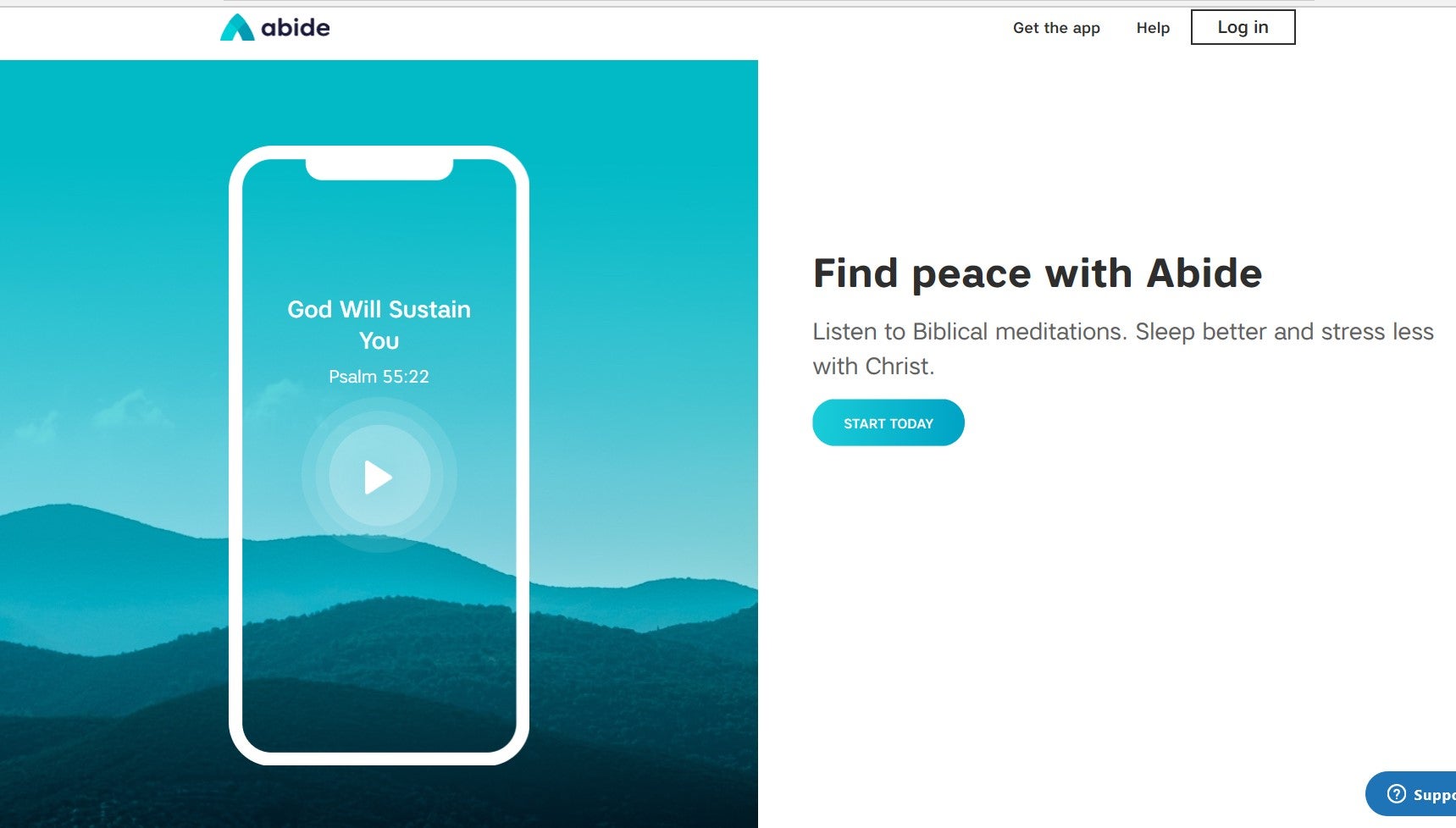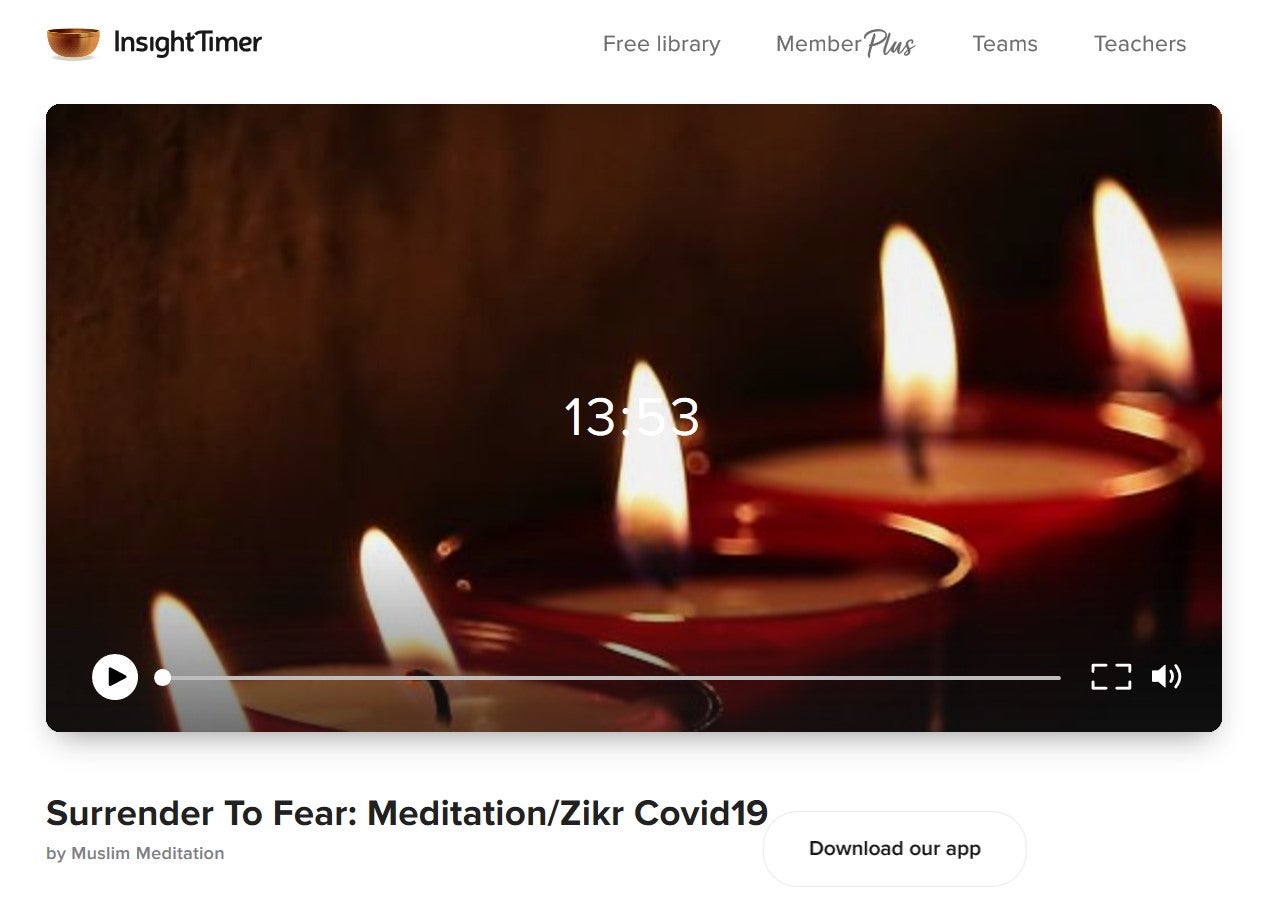Spiritualizing Confinement and the Rise of Meditation Apps
contributed by Carola LOREA, 19 June 2020
A quick look at the last posts published on our blog CoronAsur will suffice to state that numerous religious communities have employed all the technologies at their disposal to livestream rituals and host online gatherings, in a ‘virtual’ as opposed to ‘physical’ realm.
These phenomena have urged us to rethink the sensory dimension of religious experience and formulate new ways to explore aesthetic communities of faith in their disembodied online interactions.
However, instead of looking at the religious responses to the COVID-19 pandemic as necessarily de-sensorialized and disembodied phenomena, thus posing the realm of new media, digital, and virtual mediations in sharp opposition to a real, physical, somatic sphere of religious experience, I propose to consider the many ways in which the pandemic-induced confinement has triggered forms of re-embodiment and re-sensorialized engagement with the material and affective interiority of the individual mind-body complex. In this piece I bring together social phenomena as disparate as Bengali Fakirs’ spiritual training and cosmopolitan phone app users as they both draw from established sets of techniques for the body-mind complex of secluded individuals.

Spiritual preceptor and musician Jalal Fakir. Photo by the author (Dubrajpur, West Bengal, 2013)
Jalal Fakir lives at the shrine of Alam Baba: a majar, which is a place of worship centered around the tomb of a mystic saint in West Bengal. Alam Baba ‘came from Arabia’, ‘many years before the British came’, ‘when there was no railway in Bengal’. He used to ride on a tiger, holding a snake in his hand. Which is why, the locals explain, the place is full of snakes but they are harmless and most peaceful. The majar is right by the railway tracks, separated only by a big old banyan tree. Only the family of the khadim, the person in charge of the majar, is allowed to trim the branches every now and then, to clear the way for the train line.
Once the local government stopped paying the monthly sum to the khadim’s family for this maintenance work a number of nefarious accidents happened. A few years ago, in order to allow for the construction works to rebuild and enlarge the majar, parts of the banyan tree needed to be cut. The day the workers approached the tree they found out that the tree had magically moved a few meters away, all by itself.
This is where I met Jalal Fakir, master of the marphat order – the esoteric school of Islam, also called ‘Yogic Islam’ in Bengal – and current khadim in charge of the shrine of Alam Baba. Jalal Fakir spent 12 years locked inside of a room without ever seeing the daylight. He lived confined in his small sadhana room, a room for meditation and practice, until he accomplished self-realization. A few weeks of lockdown for the sake of containing the Novel Coronavirus can’t hold a candle to his decade long spiritual routine.
Nineteenth-century Indian yogis have impressed incredulous British officials and doctors with their ability to survive in a deep meditative state for days and nights without food or water. When feeling cooped up during the lockdown with a stable WiFi and a pizza delivery one click away, one could find some comfort in the remembrance of Sadhu Haridas, a Fakir who in 1837 was buried (and survived) underground for forty days in the presence of the Maharaja, as a demonstration of his spiritual power.

“A Fakir”. Etching of François Balthazar Solvyns, in Les Hindous (1808-1812). Digitized by Solvyns Project: https://www.laits.utexas.edu/solvyns-project/solvynsonline/pages/Solvyns-Etchings.htm
Confinement and isolation, ranging from enclosed orders to meditation caves, are well-known arrangements that spiritual traditions have devised in order to focus on self-disciplined awakening. Jalal Fakir’s story of twelve-year confinement as spiritual practice is only one among many stories that I have heard and scribbled in my field-work notes. It is somewhat a convention in the genre of yogic tales of isolation and enlightenment (twelve is a number that stands for completion, like the twelve months of the year).
Today's phone apps can provide for spiritual comfort within 3 minutes, guiding meditations and spiritual exercises (a popular meditation app is actually called 3 Minute Mindfulness!) – a much shorter version of Sadhu Haridas’s extraordinary feats.

Screenshot from the website of the meditation app Headspace, that helps “support you through this time of crisis”. Credit: https://www.headspace.com/covid-19
These meditation apps have witnessed an unparallelled spike since the beginning of the pandemic. For example, downloads of the meditation apps Headspace and Ten Percent Happier have doubled since mid March. The “nones”--agnostic, atheist, or non religiously affiliated--employ these apps to find release from stress, anxiety and sleep disorders, guided by a digital soundscape of soothing voices and nature sounds to concentrate on their breathing and tame restless thoughts.
Popular spirituality has commercialised Buddhist Zen, pranayama breathing, and other practices that have been part of larger religious traditions for centuries, modified in order to fit the use of modern consumers. But there are also denominational meditation apps. For Christians who are suspicious of the word mindfulness, for example, there are apps like Hallow and Abide, integrating contemplation with psalms and scripture. They both launched special features related to the pandemic, such as a 12-minute coronavirus healing prayer, and a 15-session “stuck at home” playlist.

Screenshot from the website of the Christian meditation app Abide: “Sleep better and stress less with Christ”. Credit: www.abide.co
Jalal Fakir did not have a meditation or a mindfulness phone app, nor is he going to launch one, as far as we know. The differences between his spiritual training and the proliferation of urban middle-class users of meditation and mindfulness techniques are abyssal. However, the pandemic-induced lockdown has produced a new wave of focus on the quarantined self which reminded me of the many teachings on practice (sadhana) and isolation that I gathered in the multifarious interactions with Bengali heterodox lineages as a scholar-practitioner.
This reflection took shape after reading a very mundane article in which a mix of anxiety and boredom induced a yuppie quarantined couple to meditate with the guidance of a popular meditation app. They shared their experience, emphasizing the beneficial effects of meditation on their life and marriage.
This per se did not surprise me, since I have spent years in ethnographic engagement with Tantric gurus and their disciples in South Asia, mostly married couples who decide to learn the practice (sadhana) to strengthen their relationship by connecting human and divine love, and nurture a deep sense of connection in equipoise, as I discussed elsewhere. What surprised me was the increasing number of friends and colleagues in my immediate circle, without any previous spiritual or ‘holistic self-help’ inclination, who started to download and regularly use meditation apps as soon as the lockdown was announced.
Since then, I have come across numerous articles corroborating the fact that meditation apps are experiencing a skyrocketing success. The boom of meditation apps is perhaps only paralleled by the mushrooming of yoga app users and Zoom packages of fitness classes, which I equally perceive as online devices to transmit established sets of techniques for the body-mind complex of secluded individuals.
Articles from biomedical journals as well as from world-famous academic institutions encourage meditation apps to fight COVID-19 mental stress. New meditation apps appeared on the market, while some older and well-established ones became so successful that they can afford to philanthropically offer free subscription to the overworked and overstressed healthcare professionals in the USA at the times of coronavirus.
When religions are going digital, forcing us to rewind or to rethink the “embodiment paradigm” (Csordas 1990) and the whole sensory and material shift in the study of religious phenomena, we should not overlook the simultaneous instances of re-embodiment, of re-discovery of techniques to connect with one’s body and self, which can be traced through the incredible success of meditation apps during a global health crisis. These techniques are religious in Jose Casanova’s sense of “the cult of the individual” and the sacralization of humanity which are emerging as a global civil religion, based on the shared assumption of a secularist paradigm that prompted the “interiorization of a modern individual spiritual realm which becomes the authentic space of the sacred” (2019:15).
Meditation apps are used by well-educated middle-class users in individual-centered neoliberal societies and they are directed towards self-happiness and self-betterment. Differently from the traditional training of a South Asian yogi, meditation apps on smart phones do not require painstaking acts of devotion toward a guru or murshid and strict following of his/her highly personalised and situational teachings. They do not prescribe a set of ethical rules or moral discipline, neither they ask the user to commit to the larger harmony of a sanga (a group of disciples of the same guru), or to be responsible towards a community and care for each other.
In consumerist societies based on individual freedom and success, where the only gurus are corporate celebrities and tech-savvy innovators, meditation apps are socially sanctioned ways to address the inner body and mind offering approved rituals of healing in a situation of confinement.
In sum, I suggest that among the various religious responses to COVID-19 we should not fail to address these kinds of popular responses, that could slip away from our attention just because they do not fall under the umbrella of self-defined religious activity. In fact scholars have underlined the fact that mindfulness practices were rooted in a theological background and result from a biomedicalized Buddhist framework (Wilson 2014).
While the North American market is thriving with secularised apps, some are particularly catered towards believers – as we see from the equally successful and straightforwardly religious apps that have reported a spike in searches for meditations against COVID-19-anxiety. Apart from the vast array of Christian apps— with names like Pray, One Minute Pause and, for Catholics specifically, Hallow —on Insight Timer, a free online library of meditations, the group Muslim Meditation from Karachi offers guided sessions curing the fears and anxieties of the COVID-19 spread through the repetition of the names of Allah, reshaping the Sufi practice of zikr. For Hindu web users, there are pranayama guides (see “Breathing through a lockdown”) and free online yoga courses, such as the one offered by Tirupati-based National Sanskrit University.

Screenshot of the guided meditation uploaded by Muslim Meditation on https://insighttimer.com/muslimmeditation/guided-meditations/meditation-slash-zikr-covid-19-slash-surrender-to-fear
Meditation apps and new instances of isolation-induced cultivation of the sensing and the training of the body-mind could complement our views on new media, religion, and disembodiment, even when cosmopolitan app users move away from the ‘uncool’ attribute of the religious, preferring the more ‘fashionable’ semantic fields of spirituality and holistic wellness.
While COVID-19-induced transformations in the public aspect of rituals and of places of worship have not gone unnoticed in the mainstream media coverage, the private facets of religiosity and spirituality are more difficult to analyse, quantify and report. However, these inner dimensions and more intimate aspects of people’s spiritual life are equally important in understanding how the religious landscape is changing, adopting new habits, perhaps long-lasting ones, that will affect people’s ethical and economic lives.
While affiliated religious followers have started to shift their participatory faith to online platforms, many “nones” – or non-affiliated, the most rapidly growing group in the demographics of religion in Singapore, escalating from 13% in 1980 to 18.5% in the 2015 census – might be finding the comfort once entrusted in the hands of scriptural and ritual specialists into the soothing voices of meditation apps, offering self-help and self-contentment to middle-class users in neoliberal societies.
When the unaffiliated individual triumphs, and when religious institutions are compelled to lock their doors, a salient symbol of their already declining influence on political and societal structures, particularly among the younger generations, Meditation Apps and other secularised forms of digital spirituality might become the new rituals of many post-secular Asian cities.
References:
Casanova, Jose. 2019. Global Religious And Secular Dynamics: The Modern System Of Classification. Berkeley Center for Religion, Peace and World Affairs.
Csordas, Thomas. 1990. Embodiment as a Paradigm for Anthropology. Ethos 18 (1): 5-47.
Wilson, Jeff. 2014. Mindful America: The Mutual Transformation of Buddhist Meditation and American Culture. Oxford University Press.
Carola Lorea
Dr Lorea is a scholar interested in oral traditions and popular religions in South Asia, particularly eastern India, Bangladesh and the Andaman Islands. Her research lies at the intersection between orality-literacy studies and the anthropology of religion, with a particular focus on sound cultures, folklore and heritage discourse, esoteric religious movements and the ethnography of Tantrism. Her monograph Folklore, Religion and the Songs of a Bengali Madman: a Journey Between Performance and the Politics of Cultural Representation (Brill, 2016) is the result of a four year travel-along ethnography with Baul performers in West Bengal. She received research fellowships from IIAS, Gonda Foundation (Leiden) and SAI (Heidelberg) to study travelling archives of songs in the borderlands of India and Bangladesh. She authored several articles on folklore and sacred songs, translated the works of Bengali poets and novelists, and has been socially engaged as an interpreter for Bangladeshi refugees in Italy.
Disclaimer: The views and opinions expressed in this article are those of the authors and do not necessarily reflect the position of the blog editorial team or the Asia Research Institute.
South Asia | Southeast Asia | East Asia | Other Places | Hinduism | Buddhism | Islam | Christianity | Other Religions




